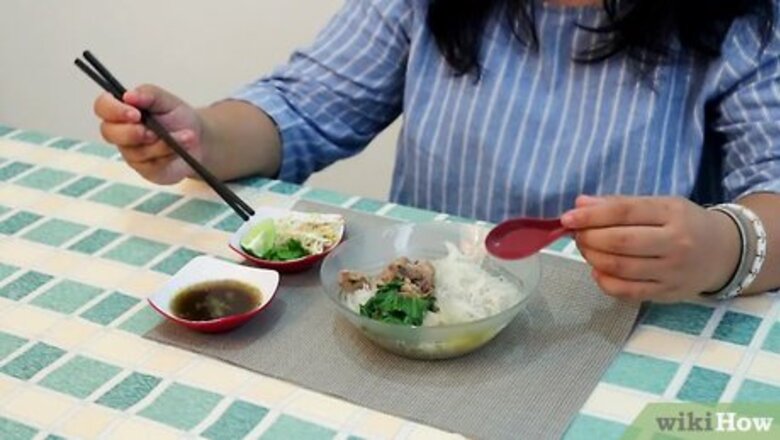
views
Consuming Pho Traditionally
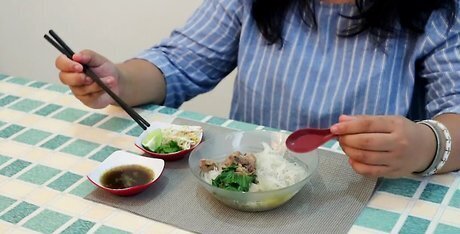
Familiarize yourself with pho eating utensils. In traditional situations, you'll be provided a spoon and a pair of chopsticks to eat pho. Generally, the spoon is held with the left hand and the chopsticks with the right, though this may be reversed if you are left handed. Additionally, you should have a small sauce dish and a holder for your chopsticks. Opposite of proper Western manners, it is alright to leave your hands on the table when eating a Vietnamese meal, like pho. This way, you can raise the bowl to your mouth to get every last bit. Wooden chopsticks can sometimes splinter when pulling them apart. In casual situations, take each chopstick and rub them together to remove splinters or burrs. However, in formal situations, this practice can be interpreted as rude. Refrain from sticking either or both chopsticks vertically into your food, or leaving your chopsticks in your food when not eating. Doing so is considered rude.
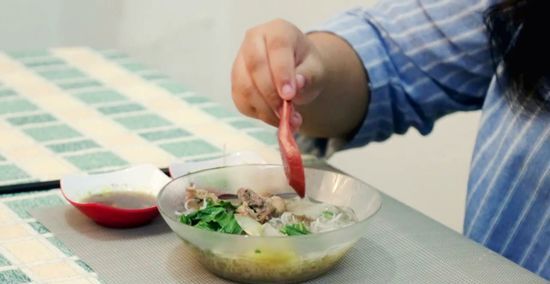
Sample and season your broth. When your pho hits the table, the first thing you'll want to do is sample the broth. If you find the broth needs a little more flavor, you can add some fish sauce, a common pho condiment, to it. Two other common flavorings added to pho broth include black pepper and lime juice. Very frequently, an entire lime wedge will be squeezed into the broth.

Put in herbs and sprouts, if you desire. The amount of beansprouts you add to your pho will depend on your preference, but in most cases roughly a handful will be enough. If your pho is served with Thai basil, de-stem the leaves and add 10 - 12 to the broth. After adding beansprouts, use your spoon to submerge them along with any pieces of rare beef. Some restaurants or households may serve pho with saw herb. If you'd like to add this to your pho, tear and add 2 - 3 of these into pieces about an inch in length. If you enjoy your food spicy, 3 or 4 slices of a serrano chili will give your pho a potent smolder. Those who are sensitive to spicy food should use fewer slices or none at all.
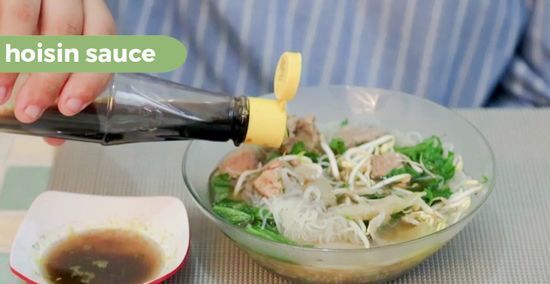
Mix your dipping sauce. Take your small sauce dish and add hoisin sauce and sriracha chili to it to make a dipping sauce. Normally, equal parts hoisin sauce and sriracha chili are used, though if you are sensitive to spicy things, less sriracha may be best. You can sample your dipping sauce by inserting the tip of your chopsticks into it and tasting the sauce on your chopsticks. If you find it too spicy or not spicy enough, you may want to add more hoisin sauce or sriracha.

Eat your pho. Take your chopsticks and spoon to mix all the ingredients of your pho evenly. When eating noodles, vegetables, and/or meat, collect combinations of ingredients together with your chopsticks and dip them into the sauce. In between bites, scoop up broth with your spoon and sip it until your pho is done. It may be difficult to eat the last bits of your pho with your spoon and chopsticks. In this situation, lay your spoon on its holder, bring the bowl to your mouth with your free hand, and guide the remnants into your mouth with your chopsticks.
Eating Pho with Western Manners
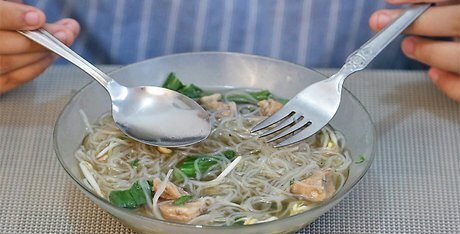
Use a soup spoon and fork for your pho. In a Western place setting, the soup spoon will be the largest. At some restaurants, a special soup spoon may be brought to you when your soup is served. Your fork will be used to wind up the pho noodles and spear other ingredients, like meat or vegetables. In British and American dining culture, the farthest right spoon is typically your soup spoon. In some cases, you may find a seafood/oyster fork to the right of your soup spoon.

Allow the pho time to cool. In Western culture, it's considered impolite to blow on soup-like dishes to cool them off. Participate in dinner conversation while waiting for it to cool. Blowing on your pho can make you seem impatient or result in soup splattering on yourself, the table, or others. You can politely check the temperature of your pho by using your spoon to stir the broth and holding it to your lips. If the spoon is uncomfortably hot, your pho probably needs more time to cool.
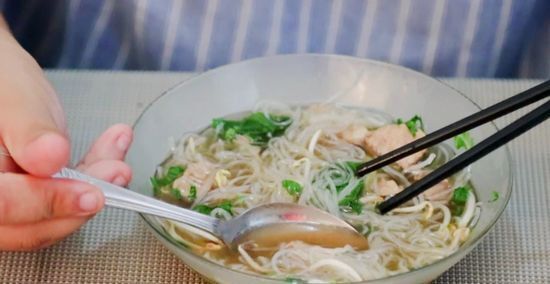
Orient the soup toward the back of the bowl. When eating pho with proper Western manners, you'll want to position your spoon toward the back of the bowl so the front of the spoon faces away from you. This will make you less likely to drip any pho on yourself while eating. Though it may feel unnatural at first, you should drink the broth by sipping it from the side of the spoon instead of putting the whole spoon in your mouth.
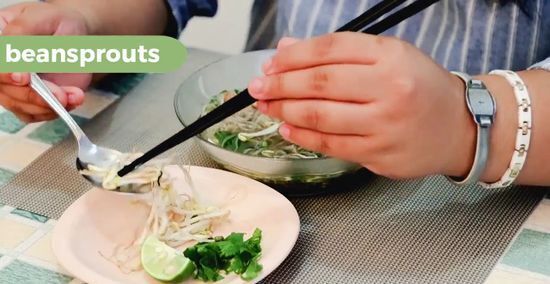
Sample your pho and add herbs and spices. Now that you pho has cooled, take your spoon and taste the broth. Add a scoop of beansprouts and use your spoon to push these and under cooked meat to the bottom of the bowl. Add herbs and spices to your pho with serving utensils. Generally, when eating with Western manners, it is considered impolite to handle herbs, spices, and other seasonings with your bare hands.
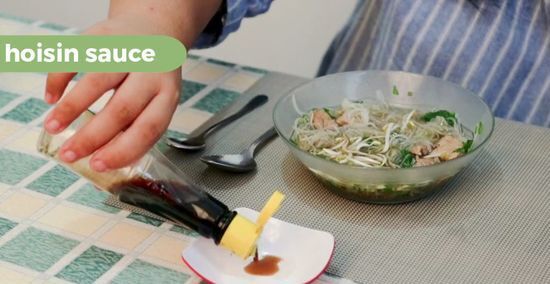
Mix the dipping sauce. The same as you would normally when eating pho, take a small dish or saucer and combine equal parts hoisin sauce and sriracha chili. If you dislike spicy food, you might want to go light on the sriracha chili or leave it out completely. You can sample your sauce to check its spiciness by dipping the tip of a utensil, like your spoon, into the sauce and tasting it.

Eat your pho. Take a fork in your right hand and swirl it through the pho noodles to catch some in the tines of your fork. Hold your spoon in your left hand, and submerge it in the broth. Then: Place the tip of your fork into the bowl of your spoon and twist the fork to collect the noodles together. Scoop or skewer meat and/or vegetables on the end of your fork, then dip the noodles and veggies into the sauce. Hold your fork over the sauce dish until it stops dripping sauce, or position your spoon closely beneath your fork to catch dripped sauce, then eat the pho. When you start getting low on pho, tilt your bowl backwards slightly to collect the remnants there. Then use your spoon to finish the meal.
Respecting Vietnamese Manners
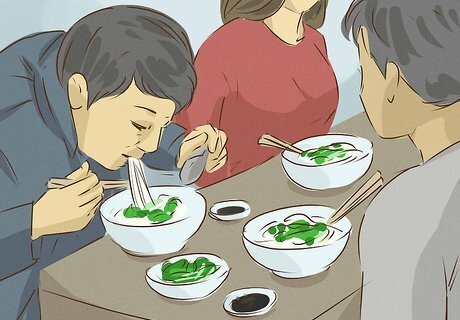
Wait for the host to eat before partaking. Especially when dining with traditional Vietnamese friends or family, you should wait for either the head of the household or the eldest member to eat first. When in doubt, wait to eat until you see one of your adult Vietnamese dining companions also doing so. Depending on your situation, your Vietnamese dinner may or may not begin with a small offering on a family Buddhist altar.
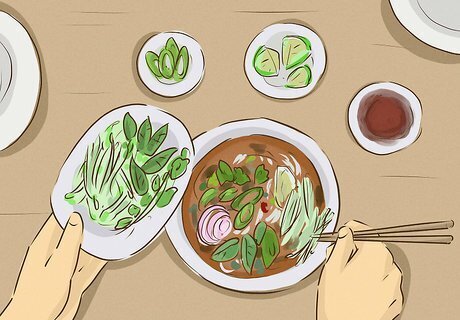
Personalize your food without hesitation. Unlike some other kinds of cuisine, Vietnamese food, including pho, is expected to be personalized to your tastes. Even special sauces that have been prepared beforehand can be poured into small sauce dishes and altered with seasonings until it suits your preferences.
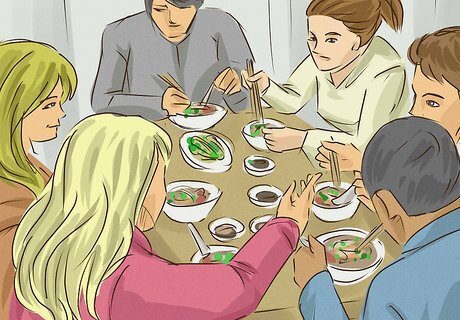
Avoid rude gestures. While eating your pho, you'll naturally gesture as you dine and converse with dinner companions. Avoid pointing at anyone with your index or middle finger, touching someone on the shoulder, or patting others on the back, as all of these are considered rude. The placement and usage of your feet is also important in Vietnamese culture. Refrain from pointing with your feet or putting your feet on tables. Excessive use of gestures may come across to traditional Vietnamese as rude, especially for women.

Acclimate to less eye contact. In Vietnamese culture, when someone feels socially unsure or like they are of lower status, it's common for them to bow frequently and avoid eye contact. This might seem disrespectful to you, but it is actually a sign of respect. Vocalizing disagreement or criticism, especially loudly or publicly, can be viewed as disrespectful. Your comments or suggestions might go over best if saved for a more private time.

Honor Vietnamese age and gender customs. Though this might be different from you home culture, Vietnamese tend to show deference by seating and serving elders most prominently, then male adults, then other members of the family, like young men, women, and children.




















Comments
0 comment